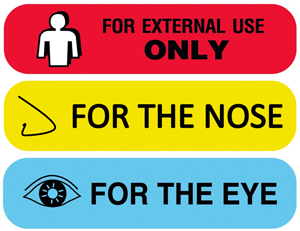The Need For Medication Instruction Labels
How big is the medication mix up problem? Here are a few surprising statistics. The majority of adults take a prescription medication. In fact, almost 60% of Americans are taking at least one prescription drug and nearly 20% are taking more than five. Furthermore, recent data from the Centers for Disease Control and Prevention, published in the Journal of the American Medical Association, suggests four visits to the ER per 1,000 adults annually are due to adverse drug effects.
Adverse Drug Effect Problem Areas
What’s more, there are a number of reasons that medications create an adverse outcome. For example:
Food And Drug Interactions
It is less common to discuss the potential problems that mixing certain foods and medications can cause, even though the potential issues are well known. For example, vitamin K can render an anticoagulant such as Coumadin ineffective. Pairing it with leafy green vegetables, broccoli or Brussels sprouts can cause problems. Similarly, grapefruit juice can lead to dangerous interactions because of a compound it contains. That compound impacts how medications are metabolized by the liver. In fact, Medical News Today reports that at least 85 medications have some type of interaction and 43 can cause a dangerous reaction.
Wrong Route of Administration
Administering a drug using using the wrong route of administration is another common problem. In fact, the FDA cited that it’s the cause of 16% of medication errors. This includes a number of issues such as:
- Swallowing a tablet instead of letting it absorb under the tongue
- Ingesting a liquid intended for injection or as a nasal spray
In fact, clearly communicating on the container how to take a drug will reduce medication errors.
Storing Medications
The efficacy of a drug can be altered depending upon where it is stored. The humidity of a bathroom shower, direct sunlight or drastic temperature deviations can cause a medication to physically change, lose potency or even decay. In addition, although a cool dry place is best for most drugs, a medication such as insulin requires refrigeration. Detailing the optimal storage conditions will drive better outcomes.
Prescriptions From Different Providers
Older adults tend to receive prescriptions from different health care providers. This can make it more difficult to track medications and identify drug-drug interactions, harmful doses and unnecessary or ineffective medications. This makes it essential to highlight potentially dangerous drug interactions, especially for older patients. Although they may have taken a single medication for a number of years and know when to take it and what foods to avoid when taking it, they don’t know the possible impact of adding other medications.
What Is The Solution?
According to Don Norman, author of The Design of Everyday Things, “An adverse drug effect is seldom the fault of an individual; it is the fault of the system. Change the people without changing the system and the problems will continue.” Better communication is essential to system improvements and medication labels are one part of the improvement process. Obviously, a prescription bottle is not a billboard. Its size and the available space limits the potential for additional information. But, a highly visible label that highlights a key instruction or guideline improves the efficacy of the medication.
United Ad Label
UAL’s in-depth knowledge of medication dispensing processes allow us to provide medication labels that enhance patient safety. Contact us to learn more about our services.


